We launched our CEF Insider newsletter nearly eight years ago, in March 2017, and we’ve seen a lot since then: a pandemic, interest-rate swings, dramatic fights between fund managers and activist shareholders, and more.
But for me, the most exciting event has been the over 200% profit one of our long-time picks, a closed-end fund (CEF) called the Adams Diversified Equity Fund (NYSE:ADX), has delivered to shareholders as of this writing.
1. Market-Beating Gains With ADX
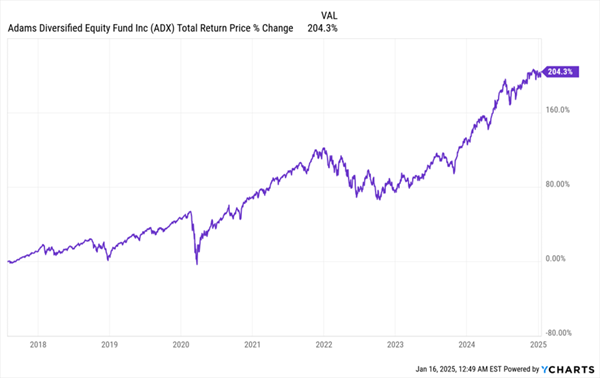
With a 204.3% return currently as I write this, ADX actually beat the S&P 500 index fund that many American investors opt for: the SPDR S&P 500 ETF Trust (SPY), which is up just 171.5% over the same time period.
That’s saved our SPY holders on management fees, but they’ve sacrificed around $3,280 for every $10,000 invested in SPY instead of ADX, as of this writing.
They’ve also sacrificed income.
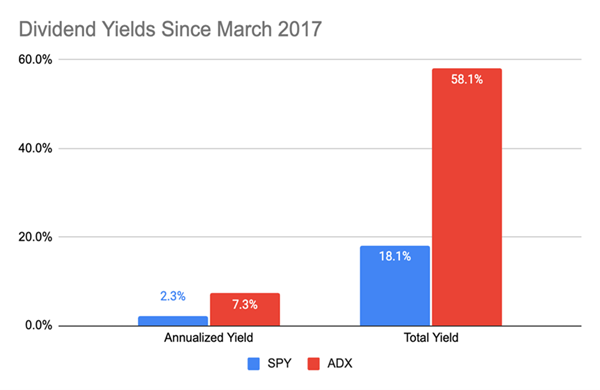
Source: CEF Insider
A simple way to think of this is that any given investor who bought ADX when we recommended it has gotten a 58.1% yield in total over that time period, or 7.3% on average. This is over triple what SPY delivered.
The longer ADX continues its performance and offers a higher yield, the longer these things are likely to continue, thanks to those superior returns compounding onto each other. And yet CEFs like ADX are often ignored by investors who just don’t know they exist, and wealth managers who’d rather funnel investors into lower-yielding index funds instead.
ADX isn’t a lone wolf. Most bond CEFs outperform their indices, too. Take, for instance, the largest corporate-bond CEF by market cap (about $6.6 billion), the PIMCO Dynamic Income Fund (NYSE:PDI).
2. PDI Outruns the Bond Market
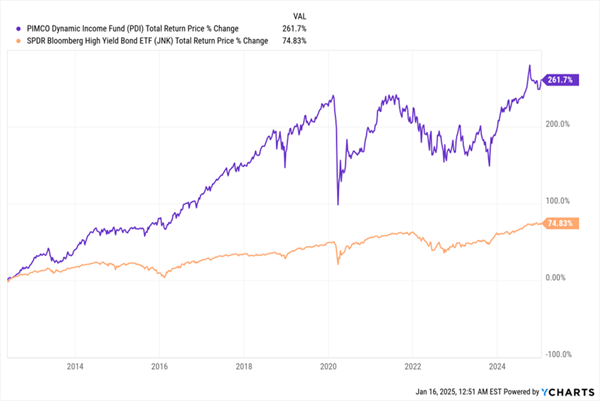
PDI (OTC:IDXG) is best compared to the so-called junk-bond index, which is tracked by the low-fee SPDR Bloomberg High Yield Bond ETF (NYSE:JNK). PDI has crushed JNK, with over triple the profits in its 12-year history.
Then, when we look at dividends, we see a similar story: PDI yields 14% as of this writing, much more than JNK’s 6.6% yield. And PDI’s dividend has not only grown, but the fund has paid many special dividends, too. JNK has done none of these things.
Bigger Yields and Payout Hikes
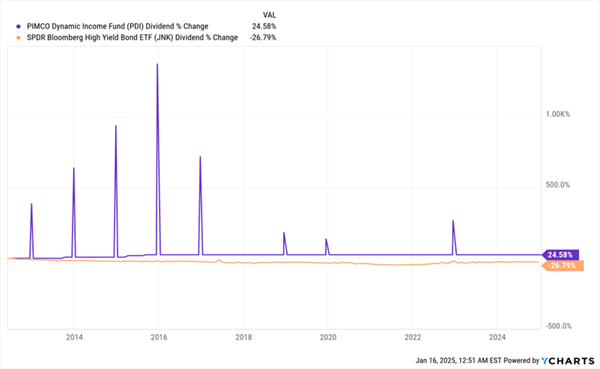
If I haven’t bored you too much, let me show you the largest municipal-bond CEF, the Nuveen AMT-Free Quality Municipal Income Fund (NYSE:NEA). Can it beat the benchmark muni-bond index fund, the iShares National Muni Bond ETF (NYSE:MUB)?
The answer probably won’t surprise you.
3. NEA Beats the Index
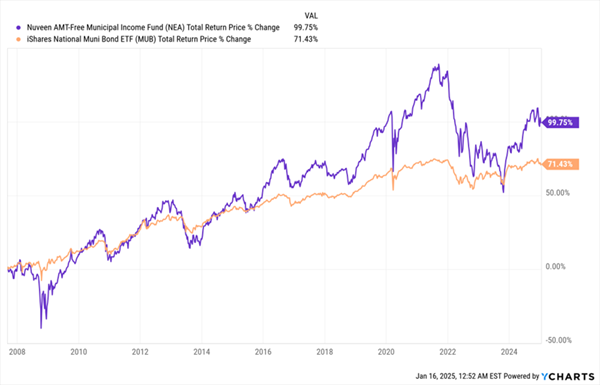
Again, the outperformance comes with higher payouts: NEA yields 7.8% as I write this, and it grew its payout in June 2024, while MUB yields a mere 3%.
Beating the Index: A Common Tale
These three funds aren’t terribly unusual; many CEFs have matched their level of performance and have delivered similarly high payouts to investors for decades—in ADX’s case, nearly a century, as this fund was launched in 1929!
Thus, it is quite strange that CEFs aren’t more popular, and while I’d love to give you a simple explanation as to why this is the case, the reality is that it’s a mix of misaligned incentives, low awareness among investors and an aggressive push from index-fund sponsors. All of it means high-yielding CEFs just aren’t well recognized among investors.
Sometimes, however, a fund will get noticed, and everything goes haywire.
PTY’s Short-Term Bonanza
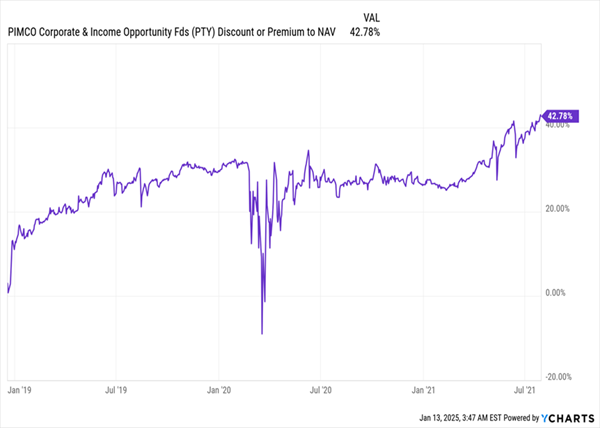
In the midst of the pandemic, a lot of traders noticed that PDI’s sister fund, the PIMCO Corporate & Income Opportunity Fund (NYSE:PTY), was crushing its index.
As a result, this fund saw its premium to net asset value (NAV, or the value of its underlying portfolio) go from near zero to a whopping 42.8%. Investors who bought into PTY (in orange below) when it was priced near par made a quick profit.
Buying Low, Selling High Premiums
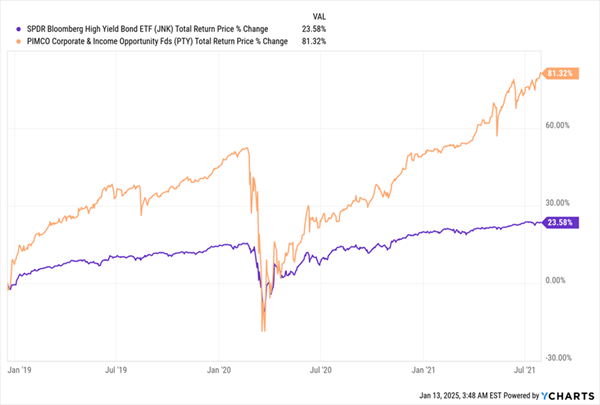
Investors who bought PTY when it was priced near par and selling when its premium was so high, investors earned 3.5 times what they could’ve gotten from the index, while also collecting a double-digit income stream.
This is one of the most appealing things about CEFs: If you buy them when they’re undervalued, such as when they trade at a big discount to NAV, and wait for that discount to shrink (or buy when a fund lacks a premium and wait for a premium to appear), you put yourself in position to amplify your gains while getting a huge income stream in the process.
This can help you turbocharge your returns, and again, it is strange that the market doesn’t recognize this opportunity.
Some, like activist hedge-fund billionaire Boaz Weinstein’s firm, Saba Capital, do see this, and specialize in buying oversold CEFs they then sell when the discount has shrunk.
I hope that more regular everyday investors take advantage of this money-making opportunity, too, which is why I keep writing CEF Insider: There are currently hundreds of discounted CEFs with an average discount of 5.6% as I write this, and yielding an average of 8.7%. That provides plenty of opportunity for profit from shrinking CEF discounts. So if you haven’t already joined this niche corner of the financial markets, it’s a great time to do so.
Disclosure: Brett Owens and Michael Foster are contrarian income investors who look for undervalued stocks/funds across the U.S. markets. Click here to learn how to profit from their strategies in the latest report, "7 Great Dividend Growth Stocks for a Secure Retirement."
